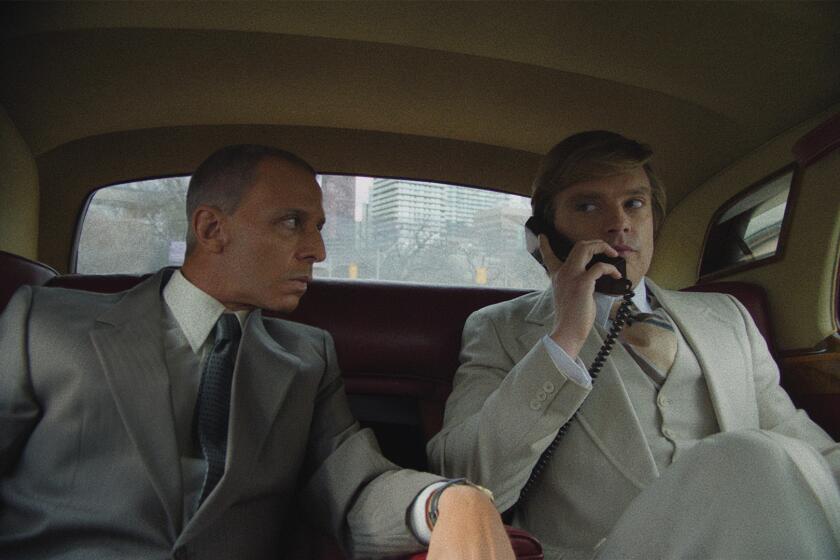Cadre of film buffs helps Netflix viewers sort through the clutter
After Greg Harty rolls out of bed in his Sherman Oaks apartment, he grabs a cup of coffee and starts his work day at a desk in the corner of his living room. His assignment: Watch three episodes of “Modern Family.”
As the hit sitcom plays, the aspiring screenwriter opens another window on his laptop and pulls up a spreadsheet. He begins picking labels — his employer, Netflix, calls them tags — to describe what he sees.
The comedy: “quirky.”
The humor: “light dark.”
The tone: “humorous,” “irreverent” and “heartfelt.”
Ty Burrell’s Phil: “silly,” “childish,” a “lovable dumbass.”
Julie Bowen’s Claire: “controlling,” “assertive.”
Ed O’Neill’s Jay: “surly,” “alpha dog.”
Later that morning, Harty uploads the spreadsheet to Netflix’s computers at its Silicon Valley headquarters; then he starts watching the movie “50/50.”
“It’s a perfect job because I don’t go to an office. I work on my own time, and I get paid to watch movies, which makes me a better writer,” said Harty, 33, who sometimes snacks on Whoppers while watching and tagging.
Harty’s choices will become part of an algorithm that produces the personal recommendations made to about 30 million viewers worldwide when they sign into Netflix. Some of the descriptions are seen by subscribers, while others are used internally.
If you like “Twin Peaks,” the algorithm says you might also enjoy “Quincy M.E.” and “Law & Order: Criminal Intent” because Harty and others on a team of freelancers have tagged each of them as “cerebral,” “suspenseful,” “TV mysteries.”
Harty is one of about 40 independent contractors, a group that includes a travel writer in Hawaii, a stay-at-home mother in Illinois, an independent filmmaker in Mexico City, and several aspiring screenwriters in Los Angeles. The work of these taggers makes it possible for Netflix to steer viewers to movies and TV programs they are likely to enjoy.
The taggers were hired for their love of entertainment and their ability to evaluate it quickly. Many are film school graduates who once worked in Hollywood — or dream of doing so.
They’re the ones who pick from more than 1,000 tags to describe thousands of movies and television series offered by Netflix to viewers in the U.S., Canada, Latin America, Great Britain and Ireland. Every movie is watched by a single person, as are at least three episodes of every TV series.
Taggers are paid several hundred dollars per week — pocket change for a company that generated $1.76 billion of revenue in the first six months of this year — to watch between 10 to 20 hours of content.
This system, dependent upon taggers’ cultural sensibilities and judgment, stands out among companies that rent or sell products online. Amazon, for instance, bases its recommendations entirely on computer analyses of comparable purchases.
Still, bloggers and tweeters have poked fun at the sometimes bizarre categories cooked up by Netflix’s computer program that uses taggers’ characterizations of content: “Sentimental dysfunctional-family dramas.” “Military 20th century period pieces based on real life.”
Without the characterizations, however, viewers face an overwhelming number of choices. Although Netflix does not disclose the number of its films and TV shows available to stream, the website InstantWatcher estimates the inventory is in excess of 14,000 titles. There are also thousands of titles on DVD.
Netflix’s tagging system is used on all of the company’s content whether it’s distributed in the U.S. or to its overseas markets. The format of that content may be different however. “Modern Family,” for instance, will soon be available to stream in the United Kingdom and Ireland, but is only on DVD in the U.S.
The company has found that 75% of its subscribers decide what to watch based on its recommendations.
“People consume more hours of video and stick with the service longer when we use these tags,” said Todd Yellin, vice president of product innovation who oversees Netflix’s recommendation engine.
When Yellin came to Netflix six years ago, computers alone were making recommendations based on what the subscriber had previously watched. The results were not always as effective as Netflix wanted, in one instance enigmatically pairing “Death Wish 3” with “The Bible Collection: Moses.”
“We were doing a really good job with mathematical crunching, but we needed to know our content better,” Yellin said. “That requires real humans.”
A film school graduate with experience making promotional videos and documentaries, Yellin wrote the first several hundred tags in 2006. Now there are more than 1,000, created by Yellin’s in-house team.
Yellin conceived of “squirm factor” to describe material that causes viewers to feel embarrassed for the characters on the screen. That tag resulted, for example, in linking the cringe-inducing British version of “The Office” with the disturbing, yet funny 1998 film “Happiness” and the cable comedy “Louie,” which chronicles bizarre and awkward events in a fictional version of comedian Louis C.K.’s life.
Yellin also decided, after much internal debate, that intellectually challenging films are better described on the website as “cerebral” rather than “brainy.”
“A lot of people thought it was too much of a ten-dollar word, but we concluded that if you like cerebral titles, then ‘cerebral’ will be a good word for you,” he recalled.
“Campy,” on the other hand, had to be abandoned for subscribers in Latin America. The term, used in the U.S. and the United Kingdom to describe such movies as “Dr. Horrible’s Sing-Along Blog” and the 1986 musical “Little Shop of Horrors,” didn’t translate into Spanish.
Analysts say Netflix’s recommendation engine is a critical reason the 15-year-old company has become a powerhouse in the home entertainment industry, despite consumer uproar last year when it raised monthly fees as much as 60% and announced, then quickly abandoned, plans to launch a separate brand for DVD rentals called Qwikster.
When customers are satisfied with what they’re watching, they’re more likely to continue paying $8 or more per month for subscriptions, according to marketing consultant Stuart Skorman.
“There’s so much content online right now and people hate wasting time watching things they don’t like. Knowing what your customer wants helps to stand out from competition,” said Skorman, who has more than 10 years experience in digital media.
For Harty, tagging makes the daily struggle to become a successful screenwriter a little easier.
Since moving seven years ago to Los Angeles from South Boston, where he grew up, he has worked as a production assistant on the medical drama “House” and as a video game tester. He was one of the first taggers hired by Yellin in late 2006 and has assessed more than 1,200 movies and TV shows.
Tagging, along with his work as a freelance artist for television, movies and video games, allows Harty to pay rent on his modest apartment, which is decorated with little more than a Red Sox blanket on the couch. DVDs crowd a bookcase and shelves over his desk. A lottery ticket is pinned to a bulletin board.
The work is compatible with a life dedicated to writing screenplays in hopes of landing an agent and making a sale to a studio. Harty grew up loving what he calls “escapist, popcorn films” like “Die Hard” and his latest script is set in the world of industrial espionage — “a James Bond meets Danny Ocean kind of thing.”
Like other Netflix taggers who meet once a year at the company’s Beverly Hills office to share complaints, learn new tags and receive feedback from Yellin’s department, Harty suffers at least one occupational hazard: It’s impossible to go to a theater, sit back with popcorn and enjoy a movie.
“I’m always tagging in the back of my mind,” he said. “When I was watching ‘Prometheus,’ I was tagging the gore. I was like, ‘It’s gory, but it’s not high gory.’”
More to Read
Only good movies
Get the Indie Focus newsletter, Mark Olsen's weekly guide to the world of cinema.
You may occasionally receive promotional content from the Los Angeles Times.








